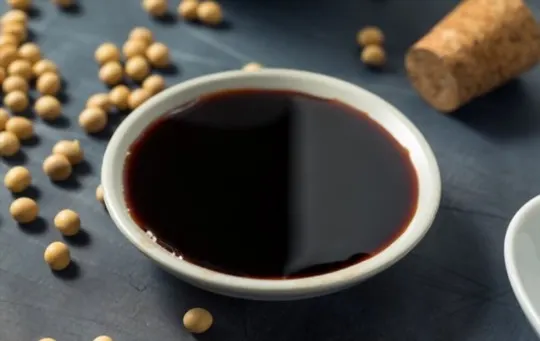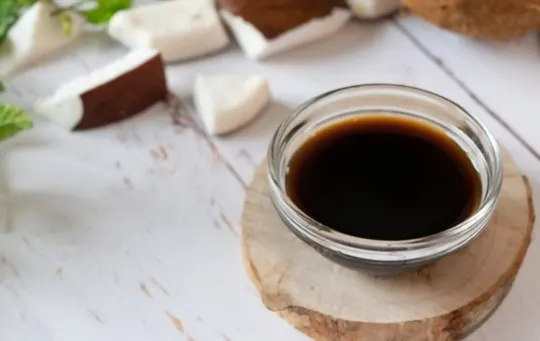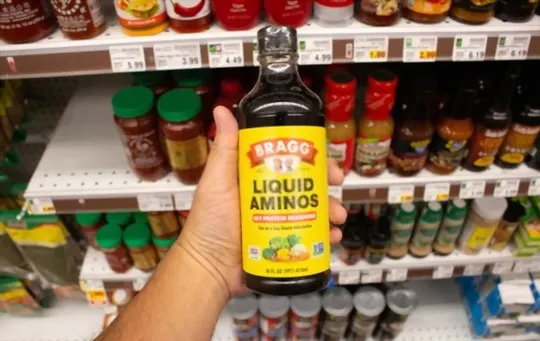Soy sauce runs out, and there you stand, staring into the abyss of your pantry. Been there, done that.
No biggie. We’ve actually stumbled upon some pretty amazing replacements that keep our dishes singing.
Think about it – you’re in the middle of cooking, and boom, the soy sauce is all gone.
You could run to the store, or you could get crafty with what you’ve got at home.
It’s like a secret mission in your own kitchen.
We’re here to guide you through it, offering alternatives that pack a punch, keep your meals flavorful, and maybe, just maybe, turn out even better than the original plan. Ready for this culinary covert op?
What is Soy Sauce?

Soy sauce is a fermented condiment made from soybeans, wheat, and salt.
It is used extensively in East Asian cuisine as a dipping sauce, marinade, and seasoning.
The flavor of soy sauce is complex, with notes of umami, sweetness, and saltiness.
The color can range from dark brown to almost black, and the texture can be either thick or thin.
Soy sauce is produced through a fermentation process that can take up to six months.
The soybeans and wheat are cooked and blended with a fermented rice mixture called koji.
This mixture is then left to ferment in large vats for several weeks or months.
Finally, the mixture is pressed to extract the liquid, which is then bottled and sold as soy sauce.
Soy sauce is a versatile ingredient that can be used in marinades, stir-fries, soups, and more.
Use soy sauce sparingly at first to see how it enhances the flavor of your dish.
Here are some tips for cooking with soy sauce:
- Soy sauce is a rich source of umami flavor, so it’s great for deglazing pans and imparting flavor to meaty dishes.
- Add a splash of soy sauce to your next batch of chili or stew for added depth of flavor.
- If you’re looking for a quick and easy way to add flavor to steamed or boiled vegetables, try seasoning them with soy sauce.
- For a quick and easy salad dressing, combine soy sauce with rice vinegar, sesame oil, and a touch of honey or sugar.
- Soy sauce can also be used as a dipping sauce for sushi, tempura, or dumplings. Simply mix it with rice vinegar and wasabi paste to taste.
When using soy sauce as a marinade, be sure to add other flavorful ingredients such as ginger, garlic, or green onions.
This will help to round out the flavors and prevent the dish from tasting too salty.
If you’re looking for a lower-sodium soy sauce, look for brands that are labeled “light” or “reduced-sodium.
” These varieties typically have 30-40% less sodium than regular soy sauce.
The 5 Best Substitutes for Soy Sauce
You have a few options if you’re looking for a soy sauce alternative.
Here are the five best substitutes for soy sauce, according to experts.
1 – Tamari Sauce

Tamari sauce is a type of soy sauce that is traditionally made without wheat.
As a result, it has a slightly deeper and more complex flavor than regular soy sauce.
Tamari sauce is also less salty than soy sauce, making it a good choice for those who are watching their sodium intake.
In addition, Tamari sauce can be used as a substitute for soy sauce in any recipe.
When substituting Tamari sauce for soy sauce, it is important to remember that the flavors will be slightly different.
However, overall, Tamari sauce is a great way to add depth of flavor to any dish.
2 – Coconut Aminos

Coconut aminos is a sauce made from coconut sap and sea salt.
It is similar to soy sauce in flavor but without the added soybeans.
The taste is salty with a hint of sweetness and can be used as a marinade, dipping sauce, or stir-fry seasoning.
Because it is made from coconuts, it is a good source of several vitamins and minerals, including potassium, magnesium, and iron.
In addition, it contains no gluten or soy, making it a great choice for those with allergies or sensitivities.
While it is not identical to soy sauce, coconut aminos can be used as a delicious and healthy replacement in many recipes.
Its unique flavor profile will surely add an extra bit of zest to any dish.
3 – Worcestershire Sauce

Worcestershire sauce is a fermented condiment that originated in England.
It is made from a blend of vinegar, soy sauce, anchovies, onion, garlic, and spices.
The sauce has a unique flavor that is both sour and savory, with a touch of sweetness.
Worcestershire sauce is commonly used as a substitute for soy sauce.
This is because it has a similar salty flavor but with added depth and complexity.
When substituting Worcestershire sauce for soy sauce, it is important to keep in mind that the former is considerably more concentrated.
As such, it should be used sparingly to avoid overwhelming the dish.
4 – Braggs Liquid Aminos

Braggs Liquid Aminos is a seasoning sauce made from soybeans and filtered water.
The soybeans are aged and then fermented with Bragg’s special blend of spices.
The result is a delicious, all-purpose seasoning that can be used in place of soy sauce.
Braggs Liquid Aminos has a rich, savory flavor that enhances the taste of any dish.
It is perfect for stir-fries, marinades, and soups.
In addition to its great taste, Braggs Liquid Aminos is also a healthy alternative to soy sauce.
It is low in sodium and calories and contains no preservatives or MSG.
For those who are looking for a healthier way to season their food, Braggs Liquid Aminos is a perfect choice.
5 – Fish Sauce

Fish sauce is a common ingredient in Southeast Asian cuisine.
It is made by fermenting fish in salt water for several months.
The resulting liquid is then strained and bottled.
Fish sauce has a strong, salty flavor and is used as a condiment or seasoning.
It is also an important ingredient in many traditional dishes, such as pad thai and pho.
While fish sauce can be used interchangeably with soy sauce, it has a distinct taste that many find more flavorful.
Fish sauce is an ideal substitute for soy sauce for those looking to add a bit of salty, umami flavor to their cooking.
In addition, fish sauce is a good source of vitamins and minerals, making it a healthier option than soy sauce.
Conclusion
In conclusion, soy sauce is a great condiment that can enhance the flavor of your meals.
However, there are a few substitutes that can be used in its place.
These substitutes include tamari sauce, fish sauce, Worcestershire sauce, liquid aminos, and fish sauce.
Each of these sauces has a unique flavor that can add depth and complexity to your dishes.
When substituting soy sauce, it is important to consider the dish’s flavor profile and choose a sauce that will complement it.

The 5 Best Substitutes for Soy Sauce
Ingredients
- Tamari Sauce
- Coconut Aminos
- Worcestershire Sauce
- Braggs Liquid Aminos
- Fish Sauce
Instructions
- Pick your favorite substitute from the list above.
- Follow cooking directions for your selected substitute with the proper ratio of ingredients.

Andrew Gray is a seasoned food writer and blogger with a wealth of experience in the restaurant and catering industries. With a passion for all things delicious, Andrew has honed his culinary expertise through his work as a personal chef and caterer.
His love for food led him to venture into food writing, where he has contributed to various online publications, sharing his knowledge and insights on the culinary world. As the proud owner of AmericasRestaurant.com, Andrew covers a wide range of topics, including recipes, restaurant reviews, product recommendations, and culinary tips.
Through his website, he aims to inspire and educate fellow food enthusiasts, offering a comprehensive resource for all things food-related.

Leave a comment